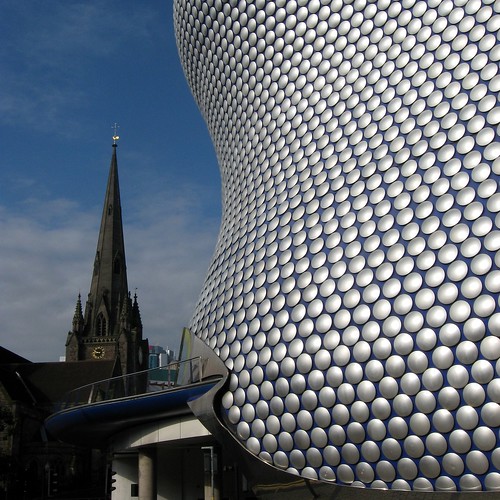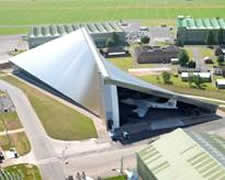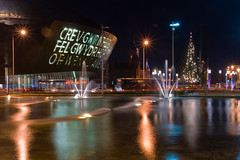Great British Architecture Great Design

30 St Mary Axe (The Gherkin), London
One of the half a dozen or more City of London office schemes by Foster & Partners on site or planned in 2001. Yet it stands out from the rest of the other offices because if its shape and its technical and environmental innovation. I see the building as the finest product of Sir Norman Foster, I’m not sure how he sees it but I think it’s his Fallingwater.
The top of the building is used as a bar and restaurant, it gives an stunning view of an open space of 360o degree
It's also one of London's most energy-saving buildings - gaps in each floor create 6 shafts that act as a natural ventilation system for the entire building. The shafts also insulate the inside office space and allow sunlight to flow through the building, reducing lighting costs. Although the Gherkin is a private building, it's stunning to look at from the outside.
It is worth knowing that the Gherkin building has been sold for £600 million in a deal thought to be the most ever paid for an office property in Britain.
Insurers Swiss Re sold the three-year-old 41-storey office block, officially known as 30 St Mary Axe, to German real estate group IVG Immobilien.
The Gherkin's sale price is double the estimated cost of construction and beats the £520 million sale last year of CityPoint in London.
Swiss Re could make £250m profit and will remain as a tenant in the building, which can command £65 a sq ft in rent.
IVG bought the building in a joint venture with investment bank Evans Randall. They are not planning any changes to the building or its use. Swiss Re chief executive Jacques Aigrain said: " IVG will preserve the superior quality of this property."
Also see:
- Official website of the 30 st mary axe
- Norman Foster's site about the project — including Quicktime movies illustrating the design process.
- 30 St Mary Axe at Emporis
- 30 St Mary Axe at SkyscraperPage.com
- London Architecture.co.uk: 30 St Mary Axe
- 30 Saint Mary Axe in the Structurae database
- About the Gherkin's energy usage
- 360x180 Panorama of St Mary Axe
- Images of 30 St Mary Axe
- Gallery, architecture images.
Selfridges at The Bullring, Birmingham:

The Selfridges store at The Bullring shopping centre is a great example of innovative and fun architecture in Britain. Designed by the Future Systems architectural practice, the design was inspired by a chain-mail Paco Rabanne dress - could this shopping mecca get any more fashionable? The building is covered with 15,000 shiny aluminium disks, which are cleaned once a year, and make the Bullring unmissable.
The Selfridges store cost £60million to build, and covers an area of 25,000m2. The store has won 8 awards including RIBA Award for Architecture 2004 and Destination of the Year Retail Week 2004.
The Eden project © Britainonview.com
Eden Project, St Austell, Cornwall:

The Eden Project is a large scale environmental project in Cornwall. Nicholas Grimshaw, one of Britain's most gifted architects, was responsible for Eden's biomes - the largest greenhouses in the country. The giant conservatories reach about 55m at their highest point and span 110m at their widest.
The very futuristic-looking bubbles were constructed in a disused China pit, and were designed to efficiently capture solar energy and make a controllable environment for the plants inside. The pillow-like structures making up the biomes are adjustable. On cold days they're pumped with more air for insulation, and on hotter days they're partially deflated to allow more cooling.
Entrance of the iconic Wales Millennium Centre with bilingual inscription reading 'Creu Gwir Fel Gwydr O Ffwrnais Arwen, In These Stones Horizons Sing' © Britainonview.com / David Angel
Wales Millennium Centre, Cardiff:
The Wales Millennium Centre has become of Cardiff's iconic sites since it opened in 2004. Situated on Cardiff Bay, it's a centre for performing arts and is home to 2 theatres, shops, bars and restaurants, and 7 resident Welsh arts organisations.
The brief to the architects, Percy Thomas, was that the building had to be 'unmistakably Welsh and internationally outstanding'. In the dome at the front of the building are 2 poetic lines formed by windows in the upstairs bar. The lines were written by Welsh poet Gwyneth Lewis - the Welsh inscription reads 'Creu Gwir fel gwydr o ffwrnais awen' which means 'Creating truth like glass from the furnace of inspiration'; and the English inscription reads 'In these stones, horizons sing'. At night, the lights in the bar area are switched on, illuminating the letters and creating a spectacular sight.
Metropolitan Cathedral of Christ the King, Liverpool:

This is one of 2 Cathedrals in Liverpool (the other is the Anglican Cathedral) – both are situated on Hope Street. In 1960, architects all over the world were invited to design a Cathedral for Liverpool which would relate to the existing Crypt, be capable of construction within 5 years, cost at the current prices no more than £1million for its shell, and most important of all, express the new spirit of the liturgy then being radically reformulated by the Second Vatican Council.
Of 300 entries from all over the world, Sir Frederick Gibberd's (1908-1984) design was chosen, and the Cathedral opened in 1967. Unlike most cathedrals, the layout of the pews is circular, with the altar in the centre. The most striking feature of the building is the raised dome in the centre, which is made out of stained glass, creating a stunning effect inside.
National Cold War Exhibition Building, RAF Museum, Shropshire:

The distinctive National Cold War Exhibition building at the RAF Museum (www.rafmuseum.org.uk/cosford/index.cfm) in Cosgrove is the world's first display dedicated to documenting the social, political and military conflicts of the Cold War. Designed by Feilden Clegg Bradley Architects, it's a physical metaphor for the Cold War's opposing forces.
The landmark building cost £12.5million, and contains 17 aircraft, military transport, missiles, memorabilia and interactive kiosks and information hotspots. The architects used materials which emphasise the building's simple and strong statement: the smooth lines of the aluminium roof dominate the exterior, and the robust industrial interior provides a stark contrast.
Tell a friend about this blog and article:
Help others find this article at Del.icio.us, Digg, Netscape, Reddit, and Stumble Upon
Help others find this article at Del.icio.us, Digg, Netscape, Reddit, and Stumble Upon




















0 comments: